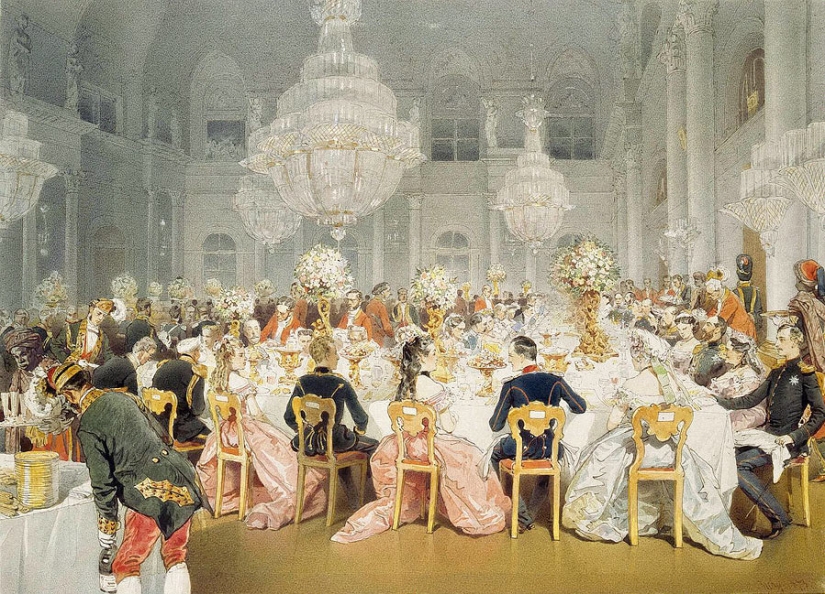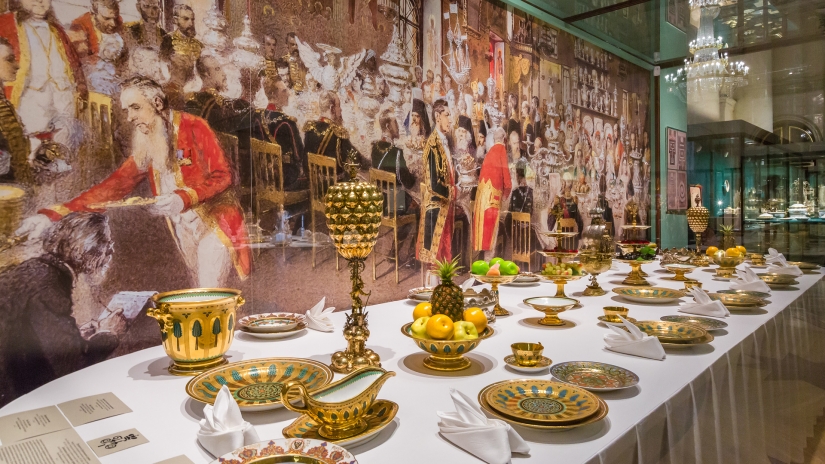From the royal table: culinary preferences of Russian emperors
Categories: Food and Drinks | History
By Pictolic https://pictolic.com/article/from-the-royal-table-culinary-preferences-of-russian-emperors1.htmlWhat did the Russian emperors like to eat? In this issue you will learn about the gastronomic preferences of the heads of the Russian Empire - from Alexander I to Alexander III.
In general, it can be argued that the Russian autocrats, starting with Catherine II, were quite moderate in food. Quite often their everyday table was distinguished by simplicity, although this, of course, did not exclude gastronomic delights during public fristies (breakfasts), lunches and dinners.


Emperor Alexander I (1777-1825) and the pozharsky cutlets that appeared thanks to him
It is safe to say that green tea in the morning and curdled milk with prunes at night are the recommendations of doctors who were responsible for the normal digestion of the tsar. But strawberries and prunes without skin are the gastronomic preferences of the emperor.

Tea service of Emperor Alexander I.
Of the national gastronomic preferences of Alexander I , memoirists mention botvinya: "The Sovereign Alexander Pavlovich was very well disposed towards the English ambassador. Once, talking to him about Russian cuisine, he asked if he had any idea about botvinya, which the emperor himself loved very much."

Botvinya.

The Imperial Ball (Mihai Zici).
With all the unpretentiousness in food, it is with the name of Alexander I that the appearance of the famous pozharsky cutlets is associated. According to legend, during the next trip to Moscow, the emperor stopped to eat in Torzhok at Pozharsky's tavern. There were veal minced cutlets on the menu, and it was them that the emperor ordered. However , the Pozharsky did not have veal. In order to avoid embarrassment, he ordered to cook chicken cutlets urgently. The tsar liked the cutlets so much that he inquired about the recipe for the cutlets, calling them "pozharsky" after the innkeeper. This random "know-how" is loved by many to this day.

It is noteworthy that such a traditional daily routine on the noble table, as grainy, powdered or keto caviar, began to penetrate into Europe under Alexander I. At first, foreigners looked at caviar as an exotic "Russian" product. The first Consul Bonaparte, to whom Count Markov sent grainy caviar, received it from his kitchen cooked: the Russian table at that time was little known in foreign lands.

Nicholas I (1796-1855) and his favorite cabbage soup (cabbage soup)
Memoirists with one voice emphasize the culinary unpretentiousness of Emperor Nicholas I. The French artist O. Vernet, who traveled to Russia with the emperor in 1842, wrote to his family: "The Emperor is a great teetotaler; he eats only cabbage soup with bacon, meat, a little game and fish, as well as pickles. He drinks only water." As for the "pickles", many of his contemporaries mentioned that the tsar really loved pickles. According to the 1840 bulletin, five pickles were to be served to Nikolai Pavlovich daily in the morning.
He loved buckwheat porridge, which was served to him in a pot. The emperor was not particularly fond of expensive fish delicacies and game. In the last years of his life, Nikolai Pavlovich preferred vegetable dishes, mashed potato soup and compote. There is no doubt that the "German" soup of mashed potatoes was prescribed to the tsar by his medical consultant M.M. Mand, he was the first to introduce therapeutic fasting "at the highest level" into medical practice.

Mashed potato soup.

Easter cakes were served in the imperial cabinet, and on Maslenitsa - morning pancakes.

Rolls.
With all the above-described culinary unpretentiousness of Emperor Nicholas I, the generally accepted Anglo-French cuisine prevailed during ceremonial dinners. A.S. Pushkin described this "typical" table of the second quarter of the XIX century in the immortal "Eugene Onegin":

Strasbourg pie.

Guryev porridge.

Alexander II (1818-1881) and meat on coals
As a rule, peasants and retired soldiers from nearby villages gathered around the hunters having breakfast. The emperor could accept the petition or order the official with the "royal box" to give the peasants a ruble, and the St. George cavaliers - three.
The eyewitness's story can be illustrated with cards from the "Hunting Deck" of the court artist M. Zichi, who repeatedly participated in such hunts. On the maps he drew the plots of one of the winter hunts of 1860. In one of the drawings, moose approached the table being set, and the palace waiters are fighting off "uninvited guests" with frying pans. In another picture, the respectable generals of the retinue decided to eat at night in a very Russian way, began to heat the pasta themselves in the kitchen and, of course, burned them. It should be noted that in the second half of the XIX century, pasta was quite expensive and, as a rule, imported from Italy (although the first pasta factory in Russia opened in Odessa at the end of the XVIII century).

Zichi maps.

Bear meat on coals.

Maria Alexandrovna, circa 1860.

Alexander III and okroshka on sour milk, as the emperor loved
Yes, Alexander III struggled with excess weight, because he believed that the shapeless, fat emperor discredited the usual handsome appearance of the Russian autocrat. But, like all losing weight, sometimes he broke down and tried to eat at an untimely time. This problem was solved by the valets. For example, in the Gatchina Palace, a washbasin, two samovars and a saucepan with a stand on which the valets could warm up something for the emperor "quickly" were stored in a room behind the private chambers of Alexander III. There are memoir mentions that the already seriously ill emperor, who was on a dairy diet, periodically asked to bring him the simplest soldier dishes from the guard barracks.
A lot of memoirs and various culinary stories from the reign of Alexander III have been preserved. If we talk about his culinary preferences, then, according to contemporaries, the tsar was moderate in food and loved a simple, healthy table. One of his most favorite dishes was a pig with horseradish "from Testov", which was necessarily ordered during visits to Moscow.
The famous life writer of old Moscow V.A. Gilyarovsky in his famous book "Moscow and Muscovites" mentioned that "the Petersburg nobility headed by the Grand dukes specially came from Petersburg to eat testovsky piglet, cancer soup with rasstegayami and the famous Guryev porridge."

Stuffed dough pig.

Cumberland sauce.
It should be noted that the culinary preferences of Alexander III remained a mystery even for dignitaries very close to the tsar. What was served during the festive meals was a high-quality version of the restaurant menu. And what the tsar ate did not go beyond the usual, very high, but standards.

Dessert table (exposition of the Arkhangelsk Museum).

From sweets in his younger years, Alexander III loved marshmallows and fruit mousse. He liked to drink hot chocolate at the end of breakfast.

Cranberry pastille.

Hot chocolate.

Serving the imperial table. Photos from the exhibition in Nicholas Hall of the Winter Palace.

Vasnetsov V.M. "The menu of the ceremonial dinner of Alexander III".

Dinner of the family of Alexander III (M. Zichi).
At a breakfast with officers and a deputation in Vladikavkaz on September 20 , the table was served: okroshka, American-style soup, pies, cold cutlets from sevryuga, bordelaise, fillet of pheasant sauvignon, beef tenderloin with mashed mushrooms, compote of pears on champagne. And on September 26, 1888: okroshka, count's soup, cake, cold sturgeon, partridges with cabbage, lamb saddle with garnish, pears in jelly.

Bordelaise sauce (Bordeaux sauce). It consists of wine (red or white), demi-glace sauce and a little tomato sauce.

A group of participants of the royal hunt for dinner; on the right — Emperor Alexander III, on his right — Empress Maria Feodorovna; the third from her - the Minister of the imperial court and estates I.I. Vorontsov-Dashkov.

Cooks cooking lunch in the forest during the royal hunt.

Emperor Alexander III (far right), Empress Maria Feodorovna (on his right hand) and participants of the royal hunt during lunch in the forest; far left (in a hat) — Prince V. Baryatinsky.
Keywords: 19th century | Emperor | Russian Empire | Tsar
Post News ArticleRecent articles

Illustrator from Canada Mark Gagne (Mark Gagne) presented a series of works called "Ink Photography" (Inked Photography). If you ...

New Year is a holiday of magic and fulfillment of wishes. Naturally, I want this holiday to be remembered for a long time and to be ...
Related articles

What did the petty criminals of the XIX century look like? We offer you a look at the faces of English prisoners held in a penal ...

Despite the constant employment and state care, many Russian rulers were still different hobby. Some like to fish, someone was a ...

The formation of Russian names occurred centuries under the influence of many factors and cultures. Despite this, our imenoslov ...

Imagine an ancient civilization, hidden for millennia underground, about which almost nothing is known. At the center of this ...